Biolaminin 411 LN (LN411)
Full-length human recombinant laminin-411
Biolaminin 411 supports diverse tissue cell types such as cells from the pancreas and the vascular, immune, nervous, and hematopoietic systems.
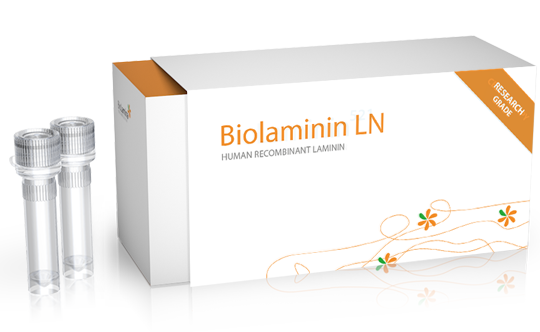
A biologically relevant culture environment
One of the main isoforms of laminins in capillaries and larger vessels produced by endothelial cells is laminin 411 and, thus, it has a pivotal role in endothelial basal laminae function (Kortesmaa, 2000; Qian, 2007; Wondimu, 2004). Transgenic mice with an α4-chain laminin deficiency exhibit severe disorganization of microvessels, leading to microcirculation abnormalities (Thyboll, 2002; Wang, 2006).
In addition, during sprouting angiogenesis laminins are produced and deposited from the stalk cells to the tip cell filopodia, and control the diameter size of the vessel lumen (Jakobsson, 2008), further supporting the importance of the protein in endothelial structure and function.
Lymphoid cells are derived from bone marrow stem cells and differentiate either in the thymus or in the bone marrow. Lymphocytes are fundamental for innate and adaptive immunity and patrol the body for foreign antigens that activate them. Laminin 411 is secreted by lymphocytes and supports their proliferation, adhesion, and migration (Geberhiwot, 2001). Laminin 411 is also involved in the survival, adhesion, and migration of blood neutrophils (Wondimu, 2004), and works as an adhesive substratum for bone marrow stem and progenitor cells and promotes progenitor cell migration in vitro (Gu, 2003).
In the embryo, differentiation and insulin expression by the pancreas β cells is initiated by and dependent on specific signals from capillary endothelial cells (Lammert, 2001). However, pancreatic cells are unable to produce the extracellular proteins laminin 411 and laminin 511, which are expressed and secreted by endothelial cells. Instead, the pancreatic islets express vascular endothelial growth factor to attract endothelial cells, providing both oxygen and nutrients and forming the essential vascular network for insulin production by the β cells (Lammert, 2003; Nikolova, 2006).
Data presented by Nikolova (2006) and colleagues suggest that treating islets with these laminins prior to transplantation will help maintain insulin production until new capillaries are formed in transplanted islets and that laminin 411 and laminin 511 in cell culture potentially could mimic the biological environment in the pancreas.
Learn more about full-length laminins:
Recommended applications
-
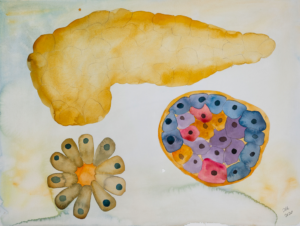
Pancreatic cells
Biorelevant culture of pancreatic cells on Biolaminin substrates The basement membrane formed next to the beta-cells contains alpha-4 and alpha-5 laminin […]View application -
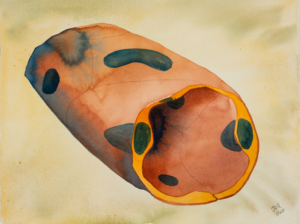
Endothelial cells
Biorelevant culture of endothelial cells Biolaminin isoforms for vascular endothelial cell culture Endothelial cells that make up the vascular network […]View application -
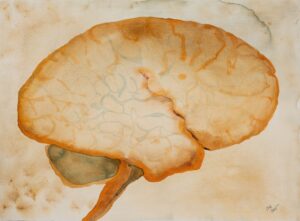
Neural cells
Biorelevant culture of neural cells on Biolaminin substrates Laminins are widely expressed in the nervous system and are essential for […]View application
Key features
Laminins in the pancreas
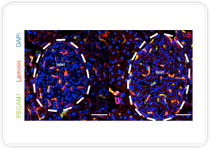
Islet endothelial cells in mouse pancreas express both laminin 411 (left) and laminin 511 (right) seen as red in these confocal microscopy images. The laminins induce a cell-signaling cascade in the β islet cells, which leads to insulin expression and cell proliferation.
Laminins by endothelial cells
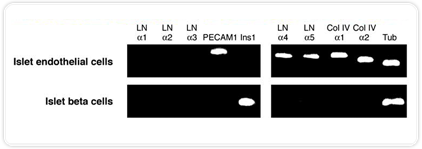
Laminins and other extracellular proteins, including collagen IV, are only produced by islet endothelial cells and not by islet β cells. Laminin 411 and laminin 511 proteins act in concert with instructive and cell-type-specific signals and are also required in liver morphogenesis and growth.
Laminins and insulin
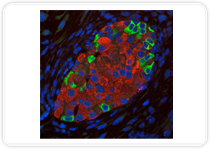
Laminin 411 and laminin 511 in cell culture can partially substitute the biological environment of the pancreas and can therefore help maintain β cell insulin production during islet transplantations before the islets are revascularized by the body.
Coating plates
1. Thaw recombinant laminins slowly at +4°C before use.
2. Dilute the thawed laminin stock solution with 1x DPBS.
3. Add the diluted laminin solution to tissue culture-treated surfaces, aiming for a final coating concentration of 0.5-2 µg/cm². The optimal coating concentration may vary depending on the specific cell line.
4. Seal the plate (e.g., with Parafilm®) to prevent evaporation, and incubate at +2°C to +8°C overnight. For faster coating, incubate at +37°C for 2 hours. Ensure the laminin solution is evenly distributed across the surface. Note that the laminin matrix will become inactivated if allowed to dry.
Important notes
Preparation and handling
- Perform all procedures under sterile conditions using aseptic techniques.
- Minimize exposure of the protein to ambient temperatures.
Storage and stability
Laminin stock solution storage
- Store the frozen laminin stock solution at -20°C to -80°C for long-term stability. Refer to the product-specific Certificate of Analysis (CoA) for detailed shelf-life information.
- Avoid repeated freeze-thaw cycles.
- For long-term storage of thawed stock solution, dispense into working aliquots and store at -30°C to -80°C. Thawed, undiluted Biolaminin stock remains stable for 3 months at +2°C to +8°C.
Coated plate storage
- Store coated plates aseptically at +2°C to +8°C for up to 4 weeks. Do not let the surface dry.
Cell culture setup
- Use appropriate culture media and dissociation reagents to create fully defined, animal component-free protocols.
- Ensure high-quality cells when transferring to the Biolaminin matrix.
- When moving your cells from another feeder-free matrix (e.g., Matrigel), we recommend starting with a smaller well format (e.g., 96-well or 48-well format) and a higher seeding density for the first few passages. This allows the cells to adapt to the laminin matrix before increasing the culture well format and lowering the seeding density.
Troubleshooting Guide
Biolaminin plate coating
Uneven cell spread is often a coating issue and may be caused by:
- Low coating concentration: Ensure the laminin coating concentration is high enough to support even cell growth. Increase the concentration if necessary.
Poor coating coverage or plate drying: Confirm that the entire surface is covered with the laminin coating solution when preparing fresh plates. Avoid drying out the plate, as this will inactivate the laminin. Prolonged time in the incubator or long storage without proper sealing can cause evaporation, leading to localized drying, often in the center of the plate.
Product name
Biolaminin 411 LN
Product code
LN411-02
LN411-0501
Declaration
For research use only
Storage
-20°C to -80°C
Concentration
0.1 mg/ml
Appearance
Clear, colorless, buffered solution with a
pH of 7.2 with 10% glycerol and 0.02% NaN3
Shipping condition
Dry Ice
Protein name
Laminin 411 (Laminin-8)
Classification
Animal origin-free, human recombinant protein
Product application
Culture of pancreatic islet cells, endothelial cells, adipocytes, and epidermal cells
Size guide
Not sure how much laminin you need? To make it easy, we have created a tool where you can calculate the amount needed for your experiments. Just choose culture well format and fill in the desired coating concentration to see the amount required.
Please see the coating instructions for concentration and volume guidelines.